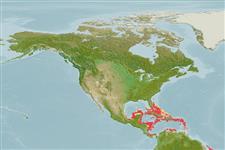>
Ovalentaria/misc (Various families in series Ovalentaria) >
Grammatidae (Basslets)
Etymology: Lipogramma: Name formed from 'lipo' for 'without' and 'gramma' for 'a line of text', referring to the absence of a well-developed lateral line.
Eponymy: Gerrit Klay was an aquarist and aquarium-fish collector who collected the holotype. [...] (Ref. 128868), visit book page.
More on author: Randall.
Environment: milieu / climate zone / depth range / distribution range
Ecologie
marien rifbewoner; diepte 45 - 145 m (Ref. 26884). Tropical
Western Central Atlantic: Bahamas and Central America to northern South America.
Grootte / Gewicht / Leeftijd
Maturity: Lm ? range ? - ? cm
Max length : 4.0 cm TL mannelijk / geslacht onbekend; (Ref. 7251)
Inhabits steep seaward slopes and walls (Ref. 9710).
Levenscyclus en paargedrag
Maturiteit | Voortplanting | Paaien | Eieren | Fecunditeit | Larven
Robins, C.R. and G.C. Ray, 1986. A field guide to Atlantic coast fishes of North America. Houghton Mifflin Company, Boston, U.S.A. 354 p. (Ref. 7251)
Status op de Rode Lijst van het IUCN (Ref. 130435: Version 2024-1)
Gevaar voor de mens
Harmless
Gebruik door de mens
Visserij: commercieel; Aquarium: Commercieel
Tools
Speciale rapporten
Download XML
Internetbronnen
Estimates based on models
Preferred temperature (Ref.
123201): 23 - 27.5, mean 26.3 °C (based on 18 cells).
Fylogenetische diversiteitsindex (Ref.
82804): PD
50 = 0.5003 [Uniqueness, from 0.5 = low to 2.0 = high].
Bayesian length-weight: a=0.01122 (0.00514 - 0.02450), b=3.04 (2.87 - 3.21), in cm total length, based on all LWR estimates for this body shape (Ref.
93245).
Trofisch niveau (Ref.
69278): 3.2 ±0.4 se; based on size and trophs of closest relatives
Fishing Vulnerability (Ref.
59153): Low vulnerability (10 of 100).
